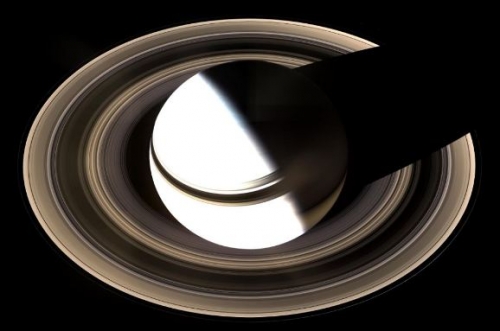
A new image released by NASA reveals a previously unseen view of Saturn and its rings using a navigation technique called a ‘pi transfer’.
The picture was taken by the space agency’s Cassini probe during a flyby past the planet’s largest moon Titan when it was about 764,000 miles (1.23 million km) from Saturn.
A pi transfer uses the gravity of the moon to alter the orbit of the Cassini spacecraft so it can gain different perspectives on Saturn and achieve a wide variety of science objectives.
Nasa said taking in the rings in their entirety was the focus of this particular imaging sequence. Therefore, the camera exposure times were just right to capture the dark-side of its rings, but longer than that required to properly expose the globe of sunlit Saturn.
As a result, the sunlit half of the planet is overexposed.
The view is a mosaic of 36 images – that is, 12 separate sets of red, green and blue images – taken over the course of about 2.5 hours, as Cassini scanned across the entire main ring system.
This view looks toward the unlit side of the rings from about 40 degrees above the ring plane.
The images in this natural-colour view were obtained with the Cassini spacecraft wide-angle camera at a distance of approximately 1.23 million km from Saturn. Image scale is 70 kilometers (44 miles) per pixel.
The planet’s moon Mimas, also known as the ‘Death Star’ because of its resemblance to the space station, is visible as a pin prick of light at the bottom right.
The image also shows the mysterious ‘spokes’ in Saturn’s B ring, just to the right of centre.
Mimas is an inner moon of Saturn and averages 246 miles (396 km) in diameter. Mimas and another Saturn moon, Rhea, have been called ‘the most heavily cratered body in the solar system.’
Based on data gathered from the Cassini spacecraft, scientists last year estimated that Saturn’s rings date back more than four billion years.
The planet is known to have 53 natural rings with two orbiting within gaps in the main rings. Some moons, such as Prometheus and Pandora, interact with ring material, shepherding the ring in its orbit.

